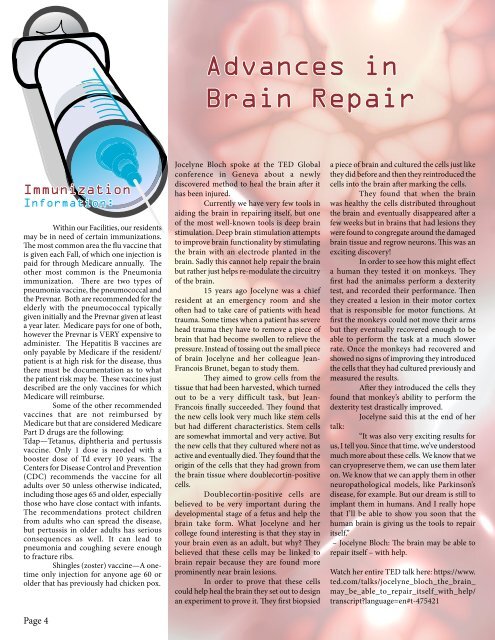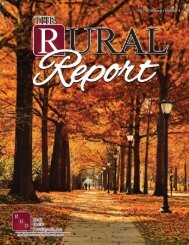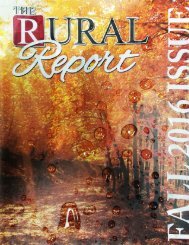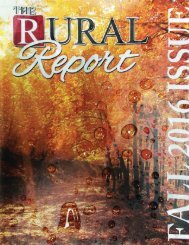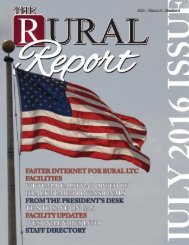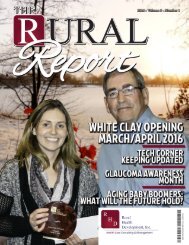RHD 2016 2nd Quarter
You also want an ePaper? Increase the reach of your titles
YUMPU automatically turns print PDFs into web optimized ePapers that Google loves.
Advances in<br />
Brain Repair<br />
Immunization<br />
Information:<br />
Within our Facilities, our residents<br />
may be in need of certain immunizations.<br />
The most common area the flu vaccine that<br />
is given each Fall, of which one injection is<br />
paid for through Medicare annually. The<br />
other most common is the Pneumonia<br />
immunization. There are two types of<br />
pneumonia vaccine, the pneumococcal and<br />
the Prevnar. Both are recommended for the<br />
elderly with the pneumococcal typically<br />
given initially and the Prevnar given at least<br />
a year later. Medicare pays for one of both,<br />
however the Prevnar is VERY expensive to<br />
administer. The Hepatitis B vaccines are<br />
only payable by Medicare if the resident/<br />
patient is at high risk for the disease, thus<br />
there must be documentation as to what<br />
the patient risk may be. These vaccines just<br />
described are the only vaccines for which<br />
Medicare will reimburse.<br />
Some of the other recommended<br />
vaccines that are not reimbursed by<br />
Medicare but that are considered Medicare<br />
Part D drugs are the following:<br />
Tdap—Tetanus, diphtheria and pertussis<br />
vaccine. Only 1 dose is needed with a<br />
booster dose of Td every 10 years. The<br />
Centers for Disease Control and Prevention<br />
(CDC) recommends the vaccine for all<br />
adults over 50 unless otherwise indicated,<br />
including those ages 65 and older, especially<br />
those who have close contact with infants.<br />
The recommendations protect children<br />
from adults who can spread the disease,<br />
but pertussis in older adults has serious<br />
consequences as well. It can lead to<br />
pneumonia and coughing severe enough<br />
to fracture ribs.<br />
Shingles (zoster) vaccine—A onetime<br />
only injection for anyone age 60 or<br />
older that has previously had chicken pox.<br />
Page 4<br />
Jocelyne Bloch spoke at the TED Global<br />
conference in Geneva about a newly<br />
discovered method to heal the brain after it<br />
has been injured.<br />
Currently we have very few tools in<br />
aiding the brain in repairing itself, but one<br />
of the most well-known tools is deep brain<br />
stimulation. Deep brain stimulation attempts<br />
to improve brain functionality by stimulating<br />
the brain with an electrode planted in the<br />
brain. Sadly this cannot help repair the brain<br />
but rather just helps re-modulate the circuitry<br />
of the brain.<br />
15 years ago Jocelyne was a chief<br />
resident at an emergency room and she<br />
often had to take care of patients with head<br />
trauma. Some times when a patient has severe<br />
head trauma they have to remove a piece of<br />
brain that had become swollen to relieve the<br />
pressure. Instead of tossing out the small piece<br />
of brain Jocelyne and her colleague Jean-<br />
Francois Brunet, began to study them.<br />
They aimed to grow cells from the<br />
tissue that had been harvested, which turned<br />
out to be a very difficult task, but Jean-<br />
Francois finally succeeded. They found that<br />
the new cells look very much like stem cells<br />
but had different characteristics. Stem cells<br />
are somewhat immortal and very active. But<br />
the new cells that they cultured where not as<br />
active and eventually died. They found that the<br />
origin of the cells that they had grown from<br />
the brain tissue where doublecortin-positive<br />
cells.<br />
Doublecortin-positive cells are<br />
believed to be very important during the<br />
developmental stage of a fetus and help the<br />
brain take form. What Jocelyne and her<br />
college found interesting is that they stay in<br />
your brain even as an adult, but why? They<br />
believed that these cells may be linked to<br />
brain repair because they are found more<br />
prominently near brain lesions.<br />
In order to prove that these cells<br />
could help heal the brain they set out to design<br />
an experiment to prove it. They first biopsied<br />
a piece of brain and cultured the cells just like<br />
they did before and then they reintroduced the<br />
cells into the brain after marking the cells.<br />
They found that when the brain<br />
was healthy the cells distributed throughout<br />
the brain and eventually disappeared after a<br />
few weeks but in brains that had lesions they<br />
were found to congregate around the damaged<br />
brain tissue and regrow neurons. This was an<br />
exciting discovery!<br />
In order to see how this might effect<br />
a human they tested it on monkeys. They<br />
first had the animalss perform a dexterity<br />
test, and recorded their performance. Then<br />
they created a lesion in their motor cortex<br />
that is responsible for motor functions. At<br />
first the monkeys could not move their arms<br />
but they eventually recovered enough to be<br />
able to perform the task at a much slower<br />
rate. Once the monkeys had recovered and<br />
showed no signs of improving they introduced<br />
the cells that they had cultured previously and<br />
measured the results.<br />
After they introduced the cells they<br />
found that monkey’s ability to perform the<br />
dexterity test drastically improved.<br />
Jocelyne said this at the end of her<br />
talk:<br />
“It was also very exciting results for<br />
us, I tell you. Since that time, we’ve understood<br />
much more about these cells. We know that we<br />
can cryopreserve them, we can use them later<br />
on. We know that we can apply them in other<br />
neuropathological models, like Parkinson’s<br />
disease, for example. But our dream is still to<br />
implant them in humans. And I really hope<br />
that I’ll be able to show you soon that the<br />
human brain is giving us the tools to repair<br />
itself.”<br />
– Jocelyne Bloch: The brain may be able to<br />
repair itself – with help.<br />
Watch her entire TED talk here: https://www.<br />
ted.com/talks/jocelyne_bloch_the_brain_<br />
may_be_able_to_repair_itself_with_help/<br />
transcript?language=en#t-475421


